You Need to Know about Sensor

Displacement sensor, also known as linear sensor, is a linear device belonging to metal induction. The function of the sensor is to convert various measured physical quantities into electricity. In the production process, the measurement of displacement is generally divided into two types: physical size measurement and mechanical displacement. According to the form of the measured variable transformation, the displacement sensor can be divided into analog and digital. The analog type can be divided into two types: physical type and structural type. Common displacement sensors are mostly analog structures, including potentiometer displacement sensors, inductive displacement sensors, self-aligning machines, capacitive displacement sensors, eddy current displacement sensors, and Linear Hall Sensors. An important advantage of digital displacement sensors is the ease with which signals can be sent directly to a computer system. Such sensors are rapidly evolving and are becoming more widely used. As a China Hall Sensor Supplier, how to judge the quality of a linear sensor?
Linear Hall Sensors
1.Linear range
The linear range of the displacement sensor is the range in which the output is proportional to the input. In theory, within this range, the sensitivity remains constant. The wider the linear range of the displacement sensor, the larger the range and the certain measurement accuracy. When selecting the displacement sensor, when the type of the displacement sensor is determined, it is first necessary to see if the range is satisfactory.
But in fact, any displacement sensor can not guarantee absolute linearity, and its linearity is also relative. When the required measurement accuracy is relatively low, within a certain range, the sensor with less nonlinear error can be approximated as linear, which will bring great convenience to the measurement.
2. Stability
The ability of the displacement sensor to remain unchanged after a period of use is called stability. In addition to the structure of the displacement sensor itself, the factors affecting the long-term stability of the displacement sensor are mainly the environment in which the displacement sensor is used. Therefore, in order to make the displacement sensor have good stability, the displacement sensor must have strong environmental adaptability. Before selecting a displacement sensor, investigate the environment in which it is used, and select the appropriate displacement sensor according to the specific use environment, or take appropriate measures to reduce the environmental impact.
The stability of the displacement sensor has a quantitative index. After the usage period, it should be recalibrated before use to determine whether the performance of the displacement sensor changes. In some cases where the sensor is required to be used for a long period and cannot be easily replaced or calibrated, the selected displacement sensor has stricter stability requirements and can withstand the test for a long time.
3. Precision
Accuracy is an important performance indicator of the displacement sensor, which is an important link related to the measurement accuracy of the entire measurement system. The higher the accuracy of the displacement sensor, the more expensive it is. Therefore, the accuracy of the displacement sensor can be as long as it meets the accuracy requirements of the entire measurement system, and it is not necessary to select too high. This makes it possible to select a relatively inexpensive and simple displacement sensor among a plurality of displacement sensors that satisfy the same measurement purpose.
If the purpose of the measurement is qualitative analysis, the displacement sensor with high repeatability can be selected. It is not suitable to use absolute precision. If it is for quantitative analysis, accurate measurement value must be obtained, and the displacement with the accuracy level can be selected sensor.
- +1 Like
- Add to Favorites
Recommend
- ElastiSense launched NEW 2.0 VERSION OF THE DS-SERIES DISPLACEMENT SENSOR
- The Working Principle Of Linear Hall Sensor
- Delve into the Importance of Crack Monitoring and the Utilization of Displacement Sensors
- Displacement sensors from ElastiSense are perfect for most applications within SHM
- Bridge Monitoring in Greece Used Six Elastisense Sensor Technology DS Displacement Sensors
- The DS-Series Displacement sensors from ElastiSense are developed especially for bridge, adding safety and reducing costs
- ElastiSense provides Sensors for off-Road and off-highway vehicles
- What is Gauss Rating and How to Use a Gauss Meter
This document is provided by Sekorm Platform for VIP exclusive service. The copyright is owned by Sekorm. Without authorization, any medias, websites or individual are not allowed to reprint. When authorizing the reprint, the link of www.sekorm.com must be indicated.






























































































































































































































































































































































































































































































































































































































































































































































































































































































